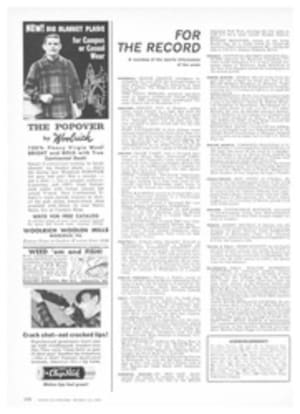
Short, fast and neat
Detroit automobile manufacturers are in a quandary—but a pleasant one. While they privately concede that they do not know where the market is going, they do know that they are making serious inroads on the small-car market developed by the Europeans. The question is why?
For months the obvious answer has seemed to be: because of the compacts. But there is a growing feeling among the manufacturers that this is only half the truth. As evidence they point to the American car buyer, who in some ways is like a fat man who has agreed to reduce but refuses to give up delicious food. The fact is that a majority of the 1,700,000 persons who bought 1960 compacts, supposedly because they were attracted by a sensible, economical car, asked for automatic transmissions, power steering, power brakes, fancy trim, air conditioning, pushbutton radios and more horsepower.
In the 1961 models they will get more of everything, particularly horsepower, which in many compacts will exceed minimum horsepower ratings for some standard-sized cars. Corvair is offering an optional 98-hp engine in 1961, in addition to the standard 80 of 1960. Falcons and Comets will be upped from 90 hp to 101, although 85 hp will be the standard. The Tempest, introduced last week (SI, Oct. 3), goes as high as 155 hp and the Lark-Cruiser 225 hp.
What most buyers seem to be worrying about is economy. There is a widely held belief that compacts are cheaper to operate because they use regular fuel and less of it. This is not precisely the case. There is little difference in fuel economy between standard-sized cars, with stick shift and six cylinders, and the compacts. Both sizes burn regular fuel, and in traffic the best compact delivers only five miles per gallon more than the standard. A compact driven 10,000 miles will save about $30 in gasoline.
If it is not true economy that the public wants, what is the allure of the smaller cars? The answer might be as simple as this: American drivers want a car that is easier to handle and easier to look at. There is evidence, too, that a growing number of them favor utilitarian cars. To take advantage of this market, Chevrolet's Corvair designers and Ford are introducing autobuses that are strikingly similar in looks to the micro bus sold by Volkswagen. The most unusual of the utility cars, however, is Corvair's Lakewood (below). It has four doors and the appearance of a conventional station wagon, but it differs from all others in one remarkable respect: its engine is in the rear.
This is considered something of a coup for Chevrolet and its chief, Ed Cole. When the Corvair sedan was placed on the market last year, experts foresaw troubles for the rear-engined make because it could not produce a station wagon, considered a necessity in the compact field.
Corvair's solutions to the tricky problems of a rear-engined station wagon are ingenious. The Lakewood's 80-hp, air-cooled motor sits snugly in the back, covered by the floorboards. A hinged panel permits easy access to the dip stick and the oil filler (the floorboard cover must be picked up if any serious work has to be done on the engine) and the battery is placed in a small compartment on the left rear side of the car. The Lakewood has the full 108-inch Corvair wheelbase, and is 53.5 inches high. This makes it the lowest of all station wagons and one of the best-looking. When the second seat is folded down, the Lake-wood has 68 cubic feet of cargo area, including 10 cubic feet up front under the hood, where the spare tire is also stored. The Corvair autobus, the Greenbrier, has Lakewood's 80-hp engine mounted in the rear. It seats six passengers comfortably and, with the third seat pulled down, nine.
A well-kept secret this year in Detroit was Ford's new Econoline series, which includes a bus and van much like the Greenbrier. Powered by an 85-hp Falcon engine, the bus sits on a short 90-inch wheelbase. It seats up to eight passengers, has an overall length of 168.4 inches and weighs 2,659 pounds. Double doors on the right side open out and make a handy frame for pitching a tent. With five passengers there are 93.4 cubic feet of cargo space, with eight passengers 32 cubic feet. In either case there is enough room for most of the gear needed on an outdoor trip.
More conventional than the autobuses and the Lakewood among the year's new cars are three new compacts, the Buick Special, Oldsmobile's F-85 and the Dodge Lancer, a younger but bigger brother to the extraordinarily successful Valiant. The Special and the F-85 are enough alike to be twins. The F-85's specifications are nearly identical to the Special's, which are: wheelbase 112 inches, length 188.4 inches, weight 2,591 pounds, width 71.3 inches, height 52.5 inches. Both cars are offered in four-door sedan and station-wagon models and both have 13-inch wheels. Their engines, too, are identical, being V-8, aluminum and water-cooled, mounted up front. The engine burns regular fuel and is rated at 155 hp.
Brothers under the hood
While some of its dimensions are slightly larger, the Lancer is a fairly close replica of the Valiant. The Valiant's 108.5-inch wheelbase is repeated in the Lancer. Both are 53.3 inches high and offer the fine-performing standard 101-hp slanted six engine, as well as optional engines which turn 145 hp. As compacts go, both are heavy. Valiant weighs in this year at a heftier 2,695 pounds (up 60 from 1960) and Lancer weighs 2,725.
Lancer's styling should win the same flattery accorded Valiant last year. As in the Valiant, the large windows extend into the roof line, and the grille, hood and bumper come together in a forward-thrust V design, making it a handsome car. Two-door and four-door sedans and four-door station wagons fill out the line.
Where do these new compacts leave George Romney and his American Motors Corporation Ramblers? Right where Romney wants to be. "Refreshing change is one thing," he said not long ago, "but incessant change has a touch of idiocy." AMC now calls its 108-inch-wheelbase Ramblers "classic," the basic design having been retained. But there have been changes, and the boxy models of two seasons ago are out. Most improved is the Rambler American, the 100-inch-wheelbase car that has lost its bathtub bulge and has sleeker lines. American will offer a convertible model this year, thus becoming the second compact convertible (Studebaker's Lark was the first).
There are now 12 compacts being produced by American manufacturers. The models have become so popular that they have forced modifications on the low-and medium-priced cars, many of which are shorter today than they were a year ago and now offer engines burning regular fuel. But the ambivalent attitude of the consumer still has Detroit guessing. Two things seem sure: U.S. buyers have more and better models to choose from than they have had in years and, until further notice, the chromium craze is over.
ILLUSTRATION
CORVAIR LAKEWOOD STATION WAGON
LUGGAGE COMPARTMENT AND SPARE TIRE
GAS TANK
80-HP AIR COOLED ENGINE
HINGED PANEL TO OIL FILLER, DIP STICK
PHOTO
CHRYSLER'S LATEST COMPACT, THE DODGE LANCER, IS BIGGER THAN THE VALIANT
PHOTO
FORD ECONOLINE BUS LOOKS LIKE VOLKSWAGEN BUT HAS FALCON ENGINE IN FRONT

